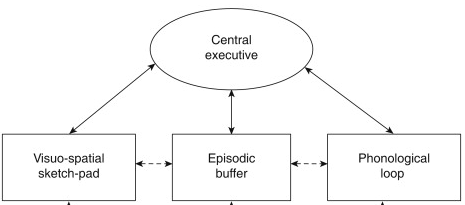Working Memory Model
1/9
There's no tags or description
Looks like no tags are added yet.
Name | Mastery | Learn | Test | Matching | Spaced |
|---|
No study sessions yet.
10 Terms
Draw a diagram of the organisation of the 4 components of the working memory model

Identify the functions of the central executive (5)
Co-ordinates, directs and monitors mental activity
Controls working memory through:
Monitoring incoming data
Allocating limited attentional resources
Allocating subsystems to tasks
Explain the functions of the phonological loop and its capacity (4)
Processes auditory information
Articulately control system = inner voice (repeats information in mind)
Phonological store = inner ear (stores acoustic information)
Capacity of 2.5s of pronunciation time
Explain the function of the visual-spatial sketchpad and its capacity (4)
Processes visual/spatial information = inner eye
Visual cache stores static pictures
Inner scribe stores 3D arrangement of items
Capacity of 3-4 objects
Identify 2 function of the episodic buffer
integrates information from other components
And from LTM
Explain how Baddeley’s findings from his dual task experiment support the WMM
Doing 2 visual tasks simultaneously had poor performance
Overloads the VSS
Doing 1 visual and 1 auditory task simultaneously had better performance
Involves both VSS and PL
Suggests that there are separate processors in STM as shown in the WMM
Explain of the case study of KF supports the WMM
Recalling words that he heard had poor performance
Only involves PL which is damaged
Recalling words that he read had better performance
Involves both PL and VSS
These findings suggest that there are separate processors in STM
What term describes when a theory is supported by more than 1 type of evidence
Triangulation
Explain the criticisms if the Central Executive concept
CE is the most important but least understood component
CE may have sub-components
Case study of EVR - could perform reasoning tasks but not decision making
Suggests reasoning and decision making are separate functions of the CE and are in different parts of the brain
Explain why the WMM is a better short-term memory theory than MSM
MSM is too simplistic
WMM is more detailed and shows complexity of information processing